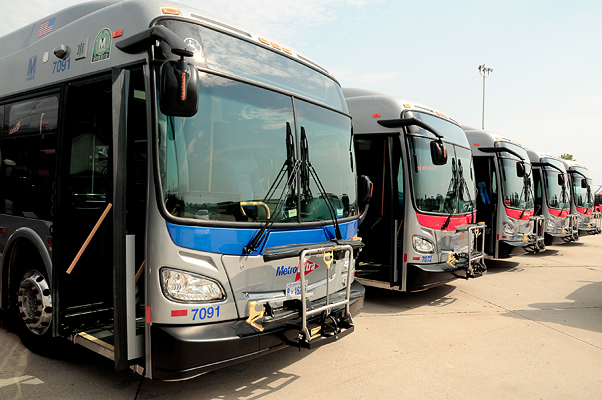
Metro buses operate in Virginia, Maryland and Washington, D.C. (Larry Levine / WMATA)
The Washington Metropolitan Area Transit Authority (Metro) is moving forward with a service-wide redesign of its bus routes, including in a few areas of Northern Virginia, improving where people want to travel and simplifying services by the summer.
The transit agency is planning to make changes in Alexandria, Fairlington and West Falls Church and Fairfax County after a two-year comprehensive review of the existing bus network called the 2025 Better Bus Network, which, according to the plan, aims to “better match when and where people want to travel, provide fast, frequent and reliable service, address inequities, and increase access to opportunity for disenfranchised communities.”
“Ultimately we ended up with a product that, I think, is going to really result in significant efficiency and savings, but also provide better service,” said Matt Letourneau, chairman of the Metro Board of Directors Finance and Capital Committee.
Letourneau, who also represents Virginia on the board that oversees Metrorail for Washington D.C., Maryland and Virginia, said some of the changes could frustrate some travelers because a particular route may not be available, “but by and large, we think this is going to be a big win for the whole region.”
In Alexandria, the Better Bus Network plan proposes to preserve rush hour service in Brookville along Taney Avenue, Park Place Condominiums and South Fairlington. The proposal also consolidates and streamlines service between Shirlington and South Fairlington.
The proposal will also restore the connection to the West Falls Church Station and surrounding development in West Falls Church. In Fairfax County, the plan will maintain rush-hour service at the Fairview Park Office Complex and service along Vaden Drive to the Fairless neighborhood and the Jim Scott Community Center.
Metro plans to roll out the service plan by June throughout its service area in the District of Columbia, Maryland and Northern Virginia, all of which provide financial contributions to the agency.
Metro is supported by ridership and fare revenue, which has steadily increased since the pandemic when travelers stayed home.
Under the new restructured Metrorail and Metrobus subsidy formula and Metro’s 2025 Approved Budget, Virginia and most of its Northern Virginia jurisdictions would see a small contribution savings under the new Better Bus Network plan.
The Board of Directors voted to update the funding formula, which determines how much jurisdictions pay to Metro, after the agency received feedback that the current formulas are “confusing” and lack transparency and predictability. The purpose of restructuring the formula is to “increase legibility and transparency,” “align service benefits” and “improve service and fiscal predictability.”
Metro established the funding formulas in 1977 and amended them in 1995.
Letourneau said additional costs could arise as the board considers other changes to the bus network. He did not mention any changes specifically.
“We were really focusing on data, on efficiency, on really trying to run a really good, efficient system,” Letourneau said. “I don’t necessarily think that we’re done growing the bus network. We just needed to really [create] a baseline that reflects … a new reality of where people are traveling.”
GET THE MORNING HEADLINES.

